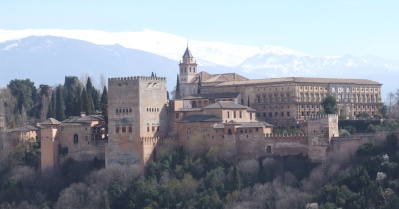
The Granada Alhambra
 The Alhambra (Arabic meaning ‘the red’) is a picturesque palace which commands Granada from its lofty perch at the foot of the Sierra Nevada Mountains. With its history stemming back to the eleventh century the foundations of the Alhambra were built by a jewish ‘prime minister’ of the then Nasrid leader. However, the Granada Alhambra as we know it today is credited to Al-Ahmar (1232-1273) who moved his seat and court from the Albayzin fortress.
The Alhambra (Arabic meaning ‘the red’) is a picturesque palace which commands Granada from its lofty perch at the foot of the Sierra Nevada Mountains. With its history stemming back to the eleventh century the foundations of the Alhambra were built by a jewish ‘prime minister’ of the then Nasrid leader. However, the Granada Alhambra as we know it today is credited to Al-Ahmar (1232-1273) who moved his seat and court from the Albayzin fortress.
Building the Granada Alhambra took over one hundred years (1248 – 1354) but the results were nothing short of remarkable. Unfortunately much of the original Moorish architecture was lost for one reason or another during the Renaissance, Napoleons conquests and an earthquake. Restoration has been ongoing since 1821 and for the most part it has been very successful.
Described by Moorish poets as “a pearl set in emeralds” the Granada Alhambra and its surroundings compliment each other. – in fact, it is hard to imagine the two apart. The pearl of course is the majestic Alhambra but one cannot ignore the splendour of the ‘Alameda de la Alhambra’ – Park of the Alhambra – which is covered in wild flowers and most famously English elms courtesy of the Duke of Wellington in 1812. While walking through the gardens you will notice the constant sound of running water which is contributed to the several fountains that are fed via an 8km conduit connected to a monastery above Granada.
For most tourists the highlight of a trip to Granada is the Alhambra, and to be perfectly honest there are few architectural gems that can match its beauty. A tour usually consists of the Nasrid Palaces, the Alcazaba and the Generalife.
The best place to start is possibly El Generalife (The Royal Orchard) if you manage to get up there early morning. This was the country residence of the Sultan, and has a huge orchard which was used as a recreational area by the court and provided the necessary provisions for the palace. The gorgeous Acequia Courtyard has a splendid irrigation system which serves as the main entry point. The palace consisting of two buildings, encloses a large courtyard, in the middle of which is a decorative pool.
By going to the splendid gardens early in the morning it gives you time to really enjoy all the nooks and crannies that would otherwise be discovered by other eager tourists. If gardens are your thing you should take your time and simply enjoy the marvellous views and the excellent work done by the many gardeners employed on the grounds.
Once you have taken in the morning sun make your way towards the Nasrid Palaces. These palaces really are the main feature of the Alhambra. Although the Alcazaba is possibly the oldest part of the complex the real treasures are found in the Nasrid Palaces, namely the Comares Palace and the Palace of the Lions. These palaces are two of the most exquisite examples of Arabic architecture. A must see for any visitor so don’t forget your camera!
Moving on to the fortress that is the Alcazaba is a good last stop because of the shops and food stalls located in the Plaza de los Aljibes. This fortress town is said to be the oldest part of the Alhambra complex and due to its strategic located it comes at no surprise that it would have been built first. Built in a triangular formation there are three east facing towers – Torre de Adarguero, Torre Quebrada and the Homage Tower – and the large Watch Tower is an imposing figure over the city far below.
Read about the Granada Alhambra? Return to Granada main page
